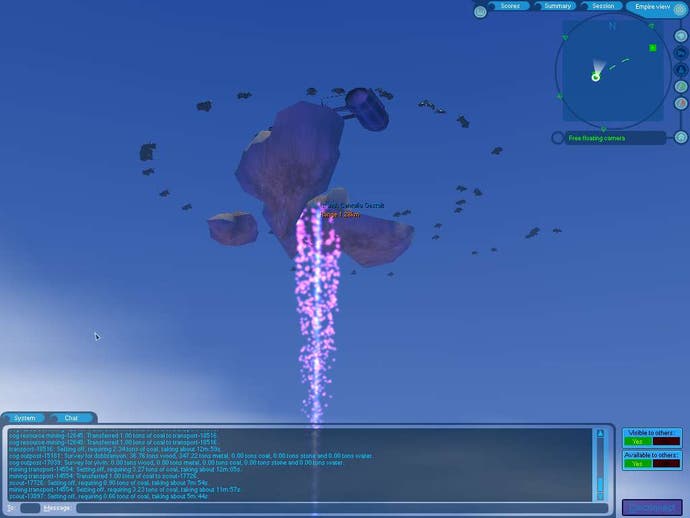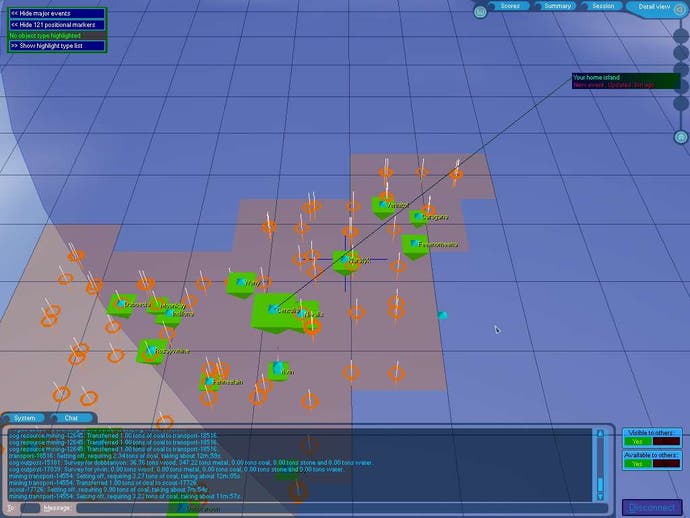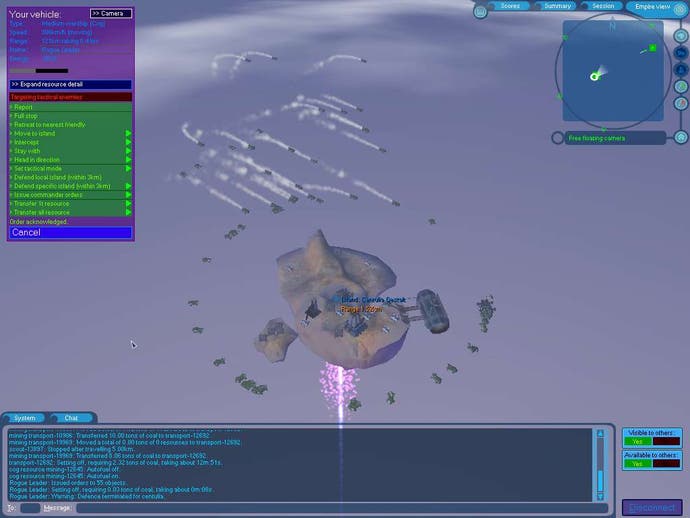Time Of Defiance
Hands On - an in-depth look at an addictive online strategy game
In a world packed to bursting point with derivative online role-playing games, it's amazing that there aren't more persistent world strategy titles around. Primitive looking text-based web browser games like the fiendishly addictive Planetarion fill the gap, but to date there have been only a handful of "real" games in the genre.

The Final Frontier
The latest such effort to emerge onto the internet is Time Of Defiance, and thanks to the appropriately named developers (Nicely Crafted Entertainment, or just plain NiCE for short) I've been beta testing the game for the last month.
At its heart, Defiance is all about exploration and exploitation. The game world is made up of the shattered remains of an exploded planet, and the goal is to capture as many of the rocky "islands" left behind as possible. Each island has limited resources and construction space, so you'll need to build your empire wisely, choosing which islands to settle on and which to simply strip mine from orbit. Given that there are about two thousand islands scattered around the play area and only a couple of hundred players in the current round of games though, there's plenty of room for expansion.
On entering a game, players are given a few spaceships and some basic resources to get them started, and dumped in a system with two planets and a quantum gate, the importance of which isn't immediately obvious. Your first task will be to get your colony up and running, and there's plenty of freedom in how you go about this. Mines are obviously a good place to start, but you could rely on a fleet of mining transports to gather resources from orbit instead. Either way you'll need silos to store your ill-gotten gains in, and a vehicle constructor to build more transports, scouts and warships. Turrets can be constructed and reinforced, and your island's defences bolstered with long range artillery, which fires lumps of rock at targets beyond the range of normal turrets. Whatever your choices though, it's always a trade-off. Even fairly large islands only have room for two or three mines, a few silos, half a dozen turrets and a vehicle constructor or two, and space can be even more limited on smaller islands. Even when you have plenty of space, it's not always economical to fill it all with buildings.

Diplomacy
While you're building up your base, you'll also want to send out some scout ships to investigate the surrounding sectors. You can't actually see a sector's contents until you have a ship or building inside its borders, which seems a bit odd when you pop across the dividing line and suddenly a new island appears right in front of your nose. But as the entire play area is split into square tiles for easy navigation, it does make a certain degree of sense, and hopping from one block to the next and dropping markers to record what you found there becomes second nature after a while.
As you go about exploring the game world, sooner or later you will find your neighbours, who may or may not be hostile. The first time I played Defiance I quickly stumbled across a few undefended islands and made the mistake of stealing them all from their previous occupant, not realising that they were just the outermost fringes of one of the biggest empires in the game. Needless to say I didn't last long, but when your empire is wiped out you can simply respawn in another part of the game world with a few basic ships to get you back on your feet. It's not something I'd recommend though, and as you don't always know where in the rankings the owner of a ship or island is, it generally pays to treat them with respect until you know better - there's a good chance that they've been playing the game a lot longer than you have.
Luckily a straightforward in-game messaging system makes it easy to chat to other players, save their id numbers to your friends list for future reference, and leave notes for them while they're offline. The game has a friendly atmosphere for the most part, and the random chat facility means that you often get messages from veterans who are happy to help you with any problems you might have. Even players who have just reduced your entire empire to smouldering ruins will quite happily stop to chat with you, if only to make sure that they caught every last ship.

Command & Control
Combat itself is arguably the weakest part of Time Of Defiance, and although the graphics make battles look a bit like Homeworld, in fact it has more in common with the likes of Planetarion than your typical real-time strategy game. At first you have a fairly limited selection of combat ships (mostly small, medium and large warships, with some boarding parties to capture enemy transports and buildings intact), but once you have gathered enough water or built a converter to turn your spare stone into valuable crystal, the quantum gate comes into play. By sending these otherwise unused resources through the gate you can buy more advanced vessels such as carriers and fast moving interceptors. These tend to be much more powerful than the mundane ships, and if anything the game is a little overbalanced in their favour right now, which makes recovering from a wipe out doubly difficult - you don't respawn with a gate, so you'll have to find another player and steal theirs before you can make much progress.
Once you've got your ships, actually controlling them is a little clumsy, as the only way to select multiple units is to assign one of them as the leader and then tell other ships to follow it. Your only options here are to assign every warship (or every ship of a particular type) within a choice of ranges to follow the leader - there's no RTS-style lassoing of troops or group selection. Another problem which will hopefully be fixed in future versions is that units don't do a very good job of following each other at the moment. Assign a fast ship to follow a slower one and it will tend to get ahead of its target, stop, turn round, back track, turn again and move ahead again, until it reaches its destination. Needless to say this wastes a lot of fuel, which is often in short supply, and means that there's no easy way to get, for example, a group of warships to escort a slow moving carrier.
The actual fighting more or less takes care of itself, with units automatically attacking any targets that come within range. Currently they don't tend to show much initiative, and often ignore friendly ships getting pounded nearby, which can leave fleets getting sucked into a fight gradually, unless somebody is there to manually target them. In theory you can just leave your warships and turrets to defend your islands automatically while you're away, but it's always best to be online when a fight is taking place to control the battle by hand. Besides which, there's nothing worse than logging on one morning to find out that a more powerful player has completely annihilated your entire empire overnight, something which has happened to me twice now. Luckily you can set up e-mail alerts to warn you if you come under attack, and SMS alerts may be possible in future versions.

Time Sapping
Despite any shortcomings of the combat and control system, Time of Defiance is still an incredibly addictive game. Just dropping in for a few minutes to check if your mining transports have filled their cargo holds or to move a few scouts around often turns into an hour long marathon session, and it's hard to tear yourself away from it. The idea is that players should be able to hold their own however much time they put into the game, but as always the truth is that the more time you spend fine-tuning your empire and exploring your surroundings, the more success you're likely to have. It's certainly a lot less intensive than most online role-playing games, which demand a huge time sacrifice just to keep up, but you can still find yourself getting sucked in for two or three hours a day if you're not careful.
Luckily the game seems to have been designed to be left running in the background while you get on with your day job. The slow pacing and a robust graphics engine means that it's easy to alt-tab into the game, give a few orders and then drop back to the desktop, while a helpful beep will inform you whenever somebody tries to chat to you, or if one of your units spots a hostile warship. The unit selection system is a bit awkward, particularly if you have a lot of ships in a small area, as they tend to overlap, but apart from that the interface is neat and easy to use, and it's improved markedly just in the few weeks that I've been playing the game. In terms of graphics the game is surprisingly good looking for a scant 6Mb download, with fairly detailed models and lovely smoke trails from weapons fire and ship movement.
Time Of Defiance isn't perfect, but as beta tests go it's certainly a highly promising start. It's already incredibly addictive, and with a little more tweaking of the AI and controls it could be even better. A frightening thought indeed. If you want to try Time Of Defiance for yourself, you can sign up at Nicely Crafted's website. At the moment the game is free to download, and will only set you back $6 (less than £4 or about €6 at current exchange rates) for a month's play. And with a full commercial launch due some time next month, now's the perfect time to get some practice in.

